400238: Policy, Power, and Politics in Health Care Provision
VerifiedAdded on 2022/09/01
|9
|2203
|72
Homework Assignment
AI Summary
This assignment explores the multifaceted aspects of health policy, power dynamics, and political influences within healthcare provision. It begins by defining the policy cycle and its stages, contrasting different models, and highlighting its significance in guiding effective policy-making. The document then distinguishes between government policies and health policies, providing examples of each, particularly within the Australian context. A key section delves into the evolution of public health, contrasting the old and new approaches and their distinct focuses. The assignment also examines the social determinants of health, exploring factors like social gradient, stress, early life, and social exclusion, and their impact on individual and community health, with specific examples. Finally, it analyzes the concept of power through Lukes' three dimensions – decision-making, non-decision-making, and ideological power – and its crucial role in policy-making processes. The assignment draws upon relevant literature to support its arguments.
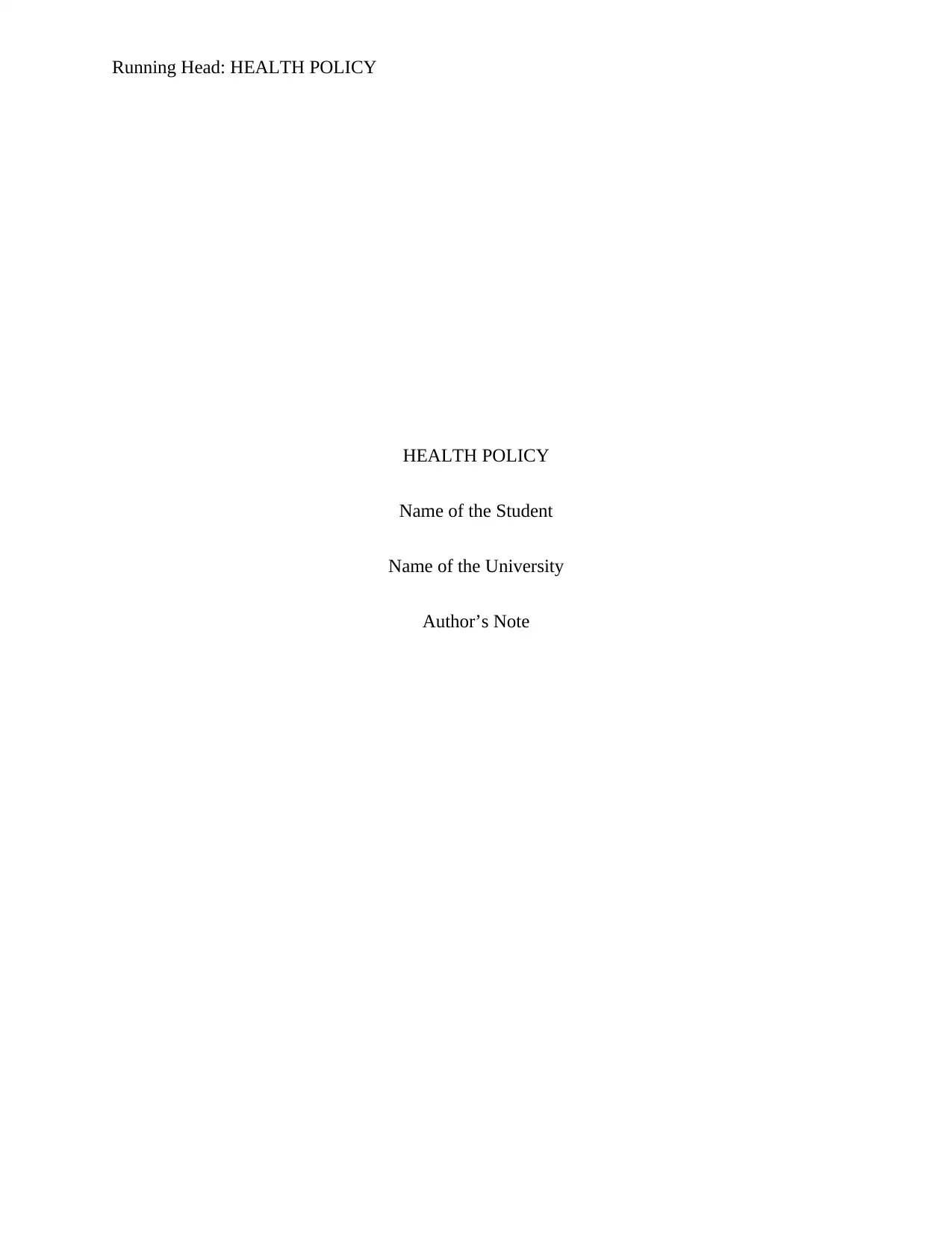
Running Head: HEALTH POLICY
HEALTH POLICY
Name of the Student
Name of the University
Author’s Note
HEALTH POLICY
Name of the Student
Name of the University
Author’s Note
Paraphrase This Document
Need a fresh take? Get an instant paraphrase of this document with our AI Paraphraser
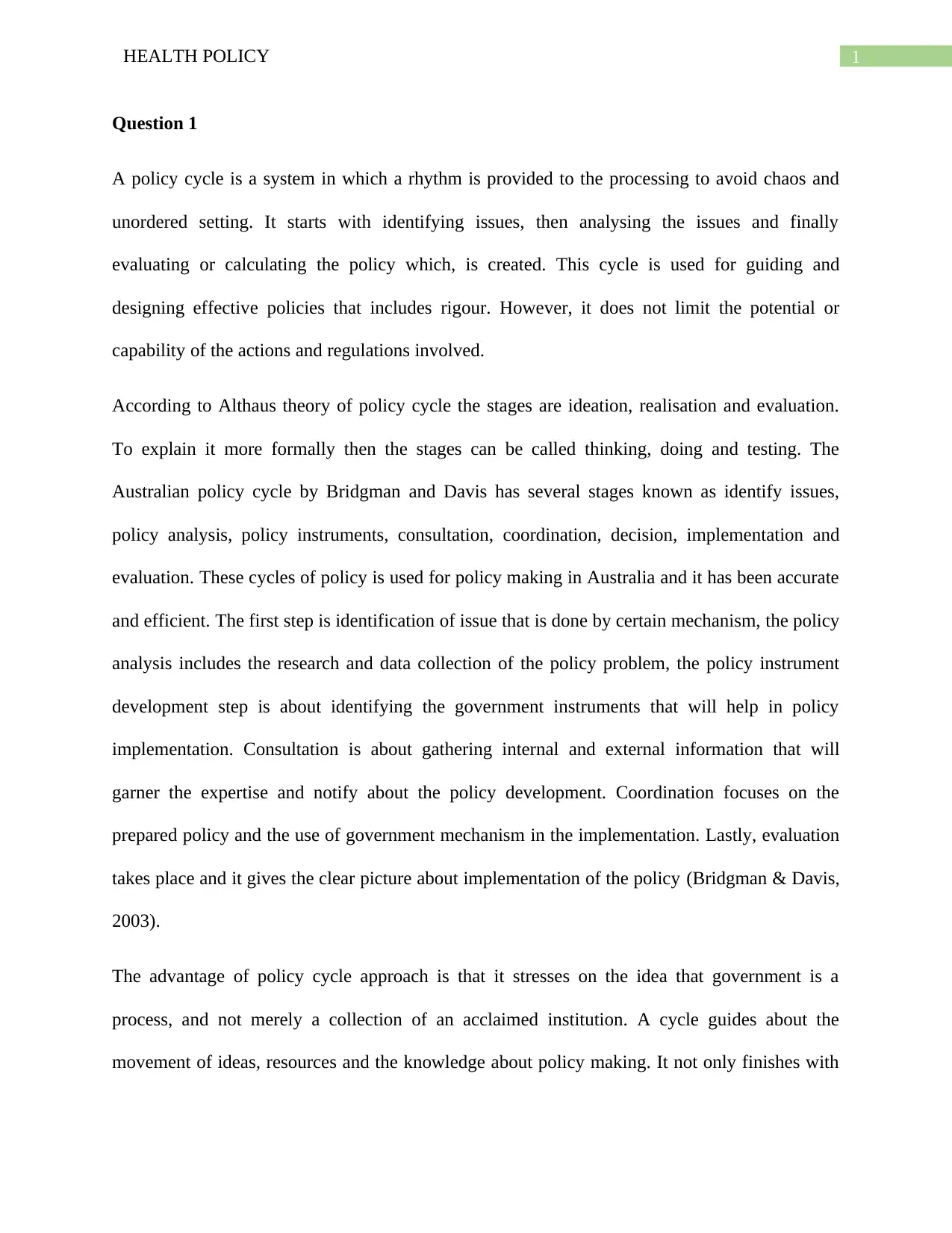
1HEALTH POLICY
Question 1
A policy cycle is a system in which a rhythm is provided to the processing to avoid chaos and
unordered setting. It starts with identifying issues, then analysing the issues and finally
evaluating or calculating the policy which, is created. This cycle is used for guiding and
designing effective policies that includes rigour. However, it does not limit the potential or
capability of the actions and regulations involved.
According to Althaus theory of policy cycle the stages are ideation, realisation and evaluation.
To explain it more formally then the stages can be called thinking, doing and testing. The
Australian policy cycle by Bridgman and Davis has several stages known as identify issues,
policy analysis, policy instruments, consultation, coordination, decision, implementation and
evaluation. These cycles of policy is used for policy making in Australia and it has been accurate
and efficient. The first step is identification of issue that is done by certain mechanism, the policy
analysis includes the research and data collection of the policy problem, the policy instrument
development step is about identifying the government instruments that will help in policy
implementation. Consultation is about gathering internal and external information that will
garner the expertise and notify about the policy development. Coordination focuses on the
prepared policy and the use of government mechanism in the implementation. Lastly, evaluation
takes place and it gives the clear picture about implementation of the policy (Bridgman & Davis,
2003).
The advantage of policy cycle approach is that it stresses on the idea that government is a
process, and not merely a collection of an acclaimed institution. A cycle guides about the
movement of ideas, resources and the knowledge about policy making. It not only finishes with
Question 1
A policy cycle is a system in which a rhythm is provided to the processing to avoid chaos and
unordered setting. It starts with identifying issues, then analysing the issues and finally
evaluating or calculating the policy which, is created. This cycle is used for guiding and
designing effective policies that includes rigour. However, it does not limit the potential or
capability of the actions and regulations involved.
According to Althaus theory of policy cycle the stages are ideation, realisation and evaluation.
To explain it more formally then the stages can be called thinking, doing and testing. The
Australian policy cycle by Bridgman and Davis has several stages known as identify issues,
policy analysis, policy instruments, consultation, coordination, decision, implementation and
evaluation. These cycles of policy is used for policy making in Australia and it has been accurate
and efficient. The first step is identification of issue that is done by certain mechanism, the policy
analysis includes the research and data collection of the policy problem, the policy instrument
development step is about identifying the government instruments that will help in policy
implementation. Consultation is about gathering internal and external information that will
garner the expertise and notify about the policy development. Coordination focuses on the
prepared policy and the use of government mechanism in the implementation. Lastly, evaluation
takes place and it gives the clear picture about implementation of the policy (Bridgman & Davis,
2003).
The advantage of policy cycle approach is that it stresses on the idea that government is a
process, and not merely a collection of an acclaimed institution. A cycle guides about the
movement of ideas, resources and the knowledge about policy making. It not only finishes with
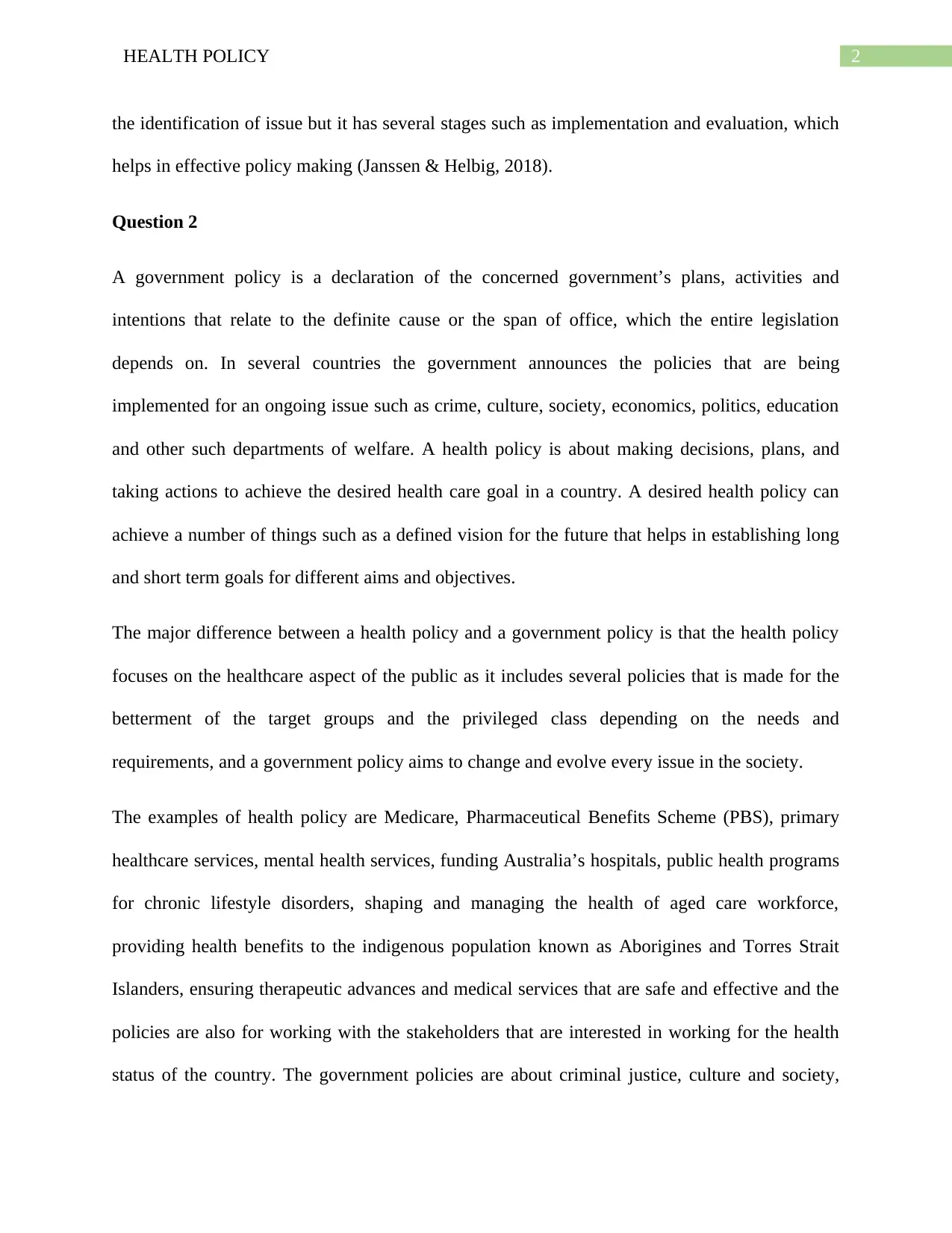
2HEALTH POLICY
the identification of issue but it has several stages such as implementation and evaluation, which
helps in effective policy making (Janssen & Helbig, 2018).
Question 2
A government policy is a declaration of the concerned government’s plans, activities and
intentions that relate to the definite cause or the span of office, which the entire legislation
depends on. In several countries the government announces the policies that are being
implemented for an ongoing issue such as crime, culture, society, economics, politics, education
and other such departments of welfare. A health policy is about making decisions, plans, and
taking actions to achieve the desired health care goal in a country. A desired health policy can
achieve a number of things such as a defined vision for the future that helps in establishing long
and short term goals for different aims and objectives.
The major difference between a health policy and a government policy is that the health policy
focuses on the healthcare aspect of the public as it includes several policies that is made for the
betterment of the target groups and the privileged class depending on the needs and
requirements, and a government policy aims to change and evolve every issue in the society.
The examples of health policy are Medicare, Pharmaceutical Benefits Scheme (PBS), primary
healthcare services, mental health services, funding Australia’s hospitals, public health programs
for chronic lifestyle disorders, shaping and managing the health of aged care workforce,
providing health benefits to the indigenous population known as Aborigines and Torres Strait
Islanders, ensuring therapeutic advances and medical services that are safe and effective and the
policies are also for working with the stakeholders that are interested in working for the health
status of the country. The government policies are about criminal justice, culture and society,
the identification of issue but it has several stages such as implementation and evaluation, which
helps in effective policy making (Janssen & Helbig, 2018).
Question 2
A government policy is a declaration of the concerned government’s plans, activities and
intentions that relate to the definite cause or the span of office, which the entire legislation
depends on. In several countries the government announces the policies that are being
implemented for an ongoing issue such as crime, culture, society, economics, politics, education
and other such departments of welfare. A health policy is about making decisions, plans, and
taking actions to achieve the desired health care goal in a country. A desired health policy can
achieve a number of things such as a defined vision for the future that helps in establishing long
and short term goals for different aims and objectives.
The major difference between a health policy and a government policy is that the health policy
focuses on the healthcare aspect of the public as it includes several policies that is made for the
betterment of the target groups and the privileged class depending on the needs and
requirements, and a government policy aims to change and evolve every issue in the society.
The examples of health policy are Medicare, Pharmaceutical Benefits Scheme (PBS), primary
healthcare services, mental health services, funding Australia’s hospitals, public health programs
for chronic lifestyle disorders, shaping and managing the health of aged care workforce,
providing health benefits to the indigenous population known as Aborigines and Torres Strait
Islanders, ensuring therapeutic advances and medical services that are safe and effective and the
policies are also for working with the stakeholders that are interested in working for the health
status of the country. The government policies are about criminal justice, culture and society,
⊘ This is a preview!⊘
Do you want full access?
Subscribe today to unlock all pages.

Trusted by 1+ million students worldwide
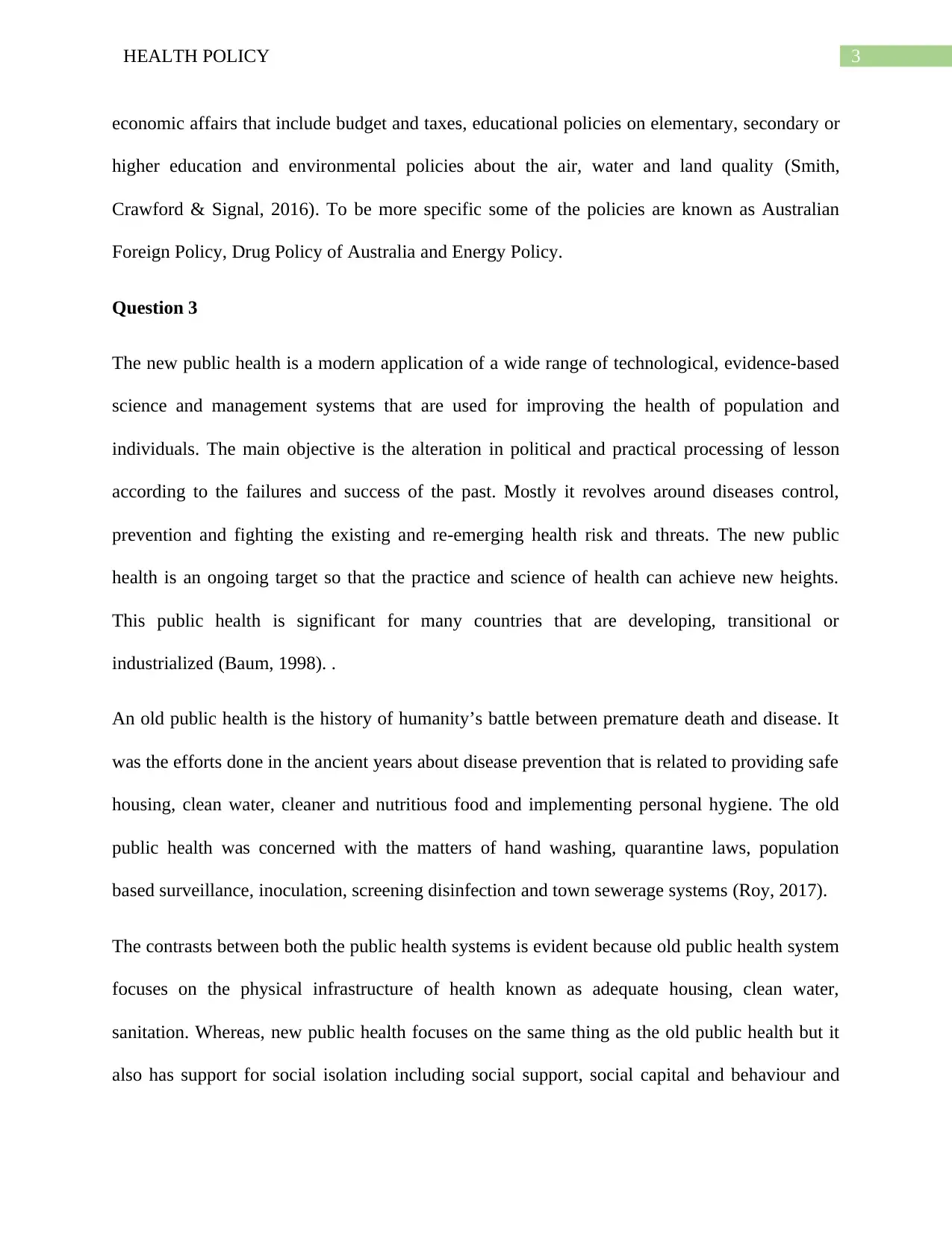
3HEALTH POLICY
economic affairs that include budget and taxes, educational policies on elementary, secondary or
higher education and environmental policies about the air, water and land quality (Smith,
Crawford & Signal, 2016). To be more specific some of the policies are known as Australian
Foreign Policy, Drug Policy of Australia and Energy Policy.
Question 3
The new public health is a modern application of a wide range of technological, evidence-based
science and management systems that are used for improving the health of population and
individuals. The main objective is the alteration in political and practical processing of lesson
according to the failures and success of the past. Mostly it revolves around diseases control,
prevention and fighting the existing and re-emerging health risk and threats. The new public
health is an ongoing target so that the practice and science of health can achieve new heights.
This public health is significant for many countries that are developing, transitional or
industrialized (Baum, 1998). .
An old public health is the history of humanity’s battle between premature death and disease. It
was the efforts done in the ancient years about disease prevention that is related to providing safe
housing, clean water, cleaner and nutritious food and implementing personal hygiene. The old
public health was concerned with the matters of hand washing, quarantine laws, population
based surveillance, inoculation, screening disinfection and town sewerage systems (Roy, 2017).
The contrasts between both the public health systems is evident because old public health system
focuses on the physical infrastructure of health known as adequate housing, clean water,
sanitation. Whereas, new public health focuses on the same thing as the old public health but it
also has support for social isolation including social support, social capital and behaviour and
economic affairs that include budget and taxes, educational policies on elementary, secondary or
higher education and environmental policies about the air, water and land quality (Smith,
Crawford & Signal, 2016). To be more specific some of the policies are known as Australian
Foreign Policy, Drug Policy of Australia and Energy Policy.
Question 3
The new public health is a modern application of a wide range of technological, evidence-based
science and management systems that are used for improving the health of population and
individuals. The main objective is the alteration in political and practical processing of lesson
according to the failures and success of the past. Mostly it revolves around diseases control,
prevention and fighting the existing and re-emerging health risk and threats. The new public
health is an ongoing target so that the practice and science of health can achieve new heights.
This public health is significant for many countries that are developing, transitional or
industrialized (Baum, 1998). .
An old public health is the history of humanity’s battle between premature death and disease. It
was the efforts done in the ancient years about disease prevention that is related to providing safe
housing, clean water, cleaner and nutritious food and implementing personal hygiene. The old
public health was concerned with the matters of hand washing, quarantine laws, population
based surveillance, inoculation, screening disinfection and town sewerage systems (Roy, 2017).
The contrasts between both the public health systems is evident because old public health system
focuses on the physical infrastructure of health known as adequate housing, clean water,
sanitation. Whereas, new public health focuses on the same thing as the old public health but it
also has support for social isolation including social support, social capital and behaviour and
Paraphrase This Document
Need a fresh take? Get an instant paraphrase of this document with our AI Paraphraser
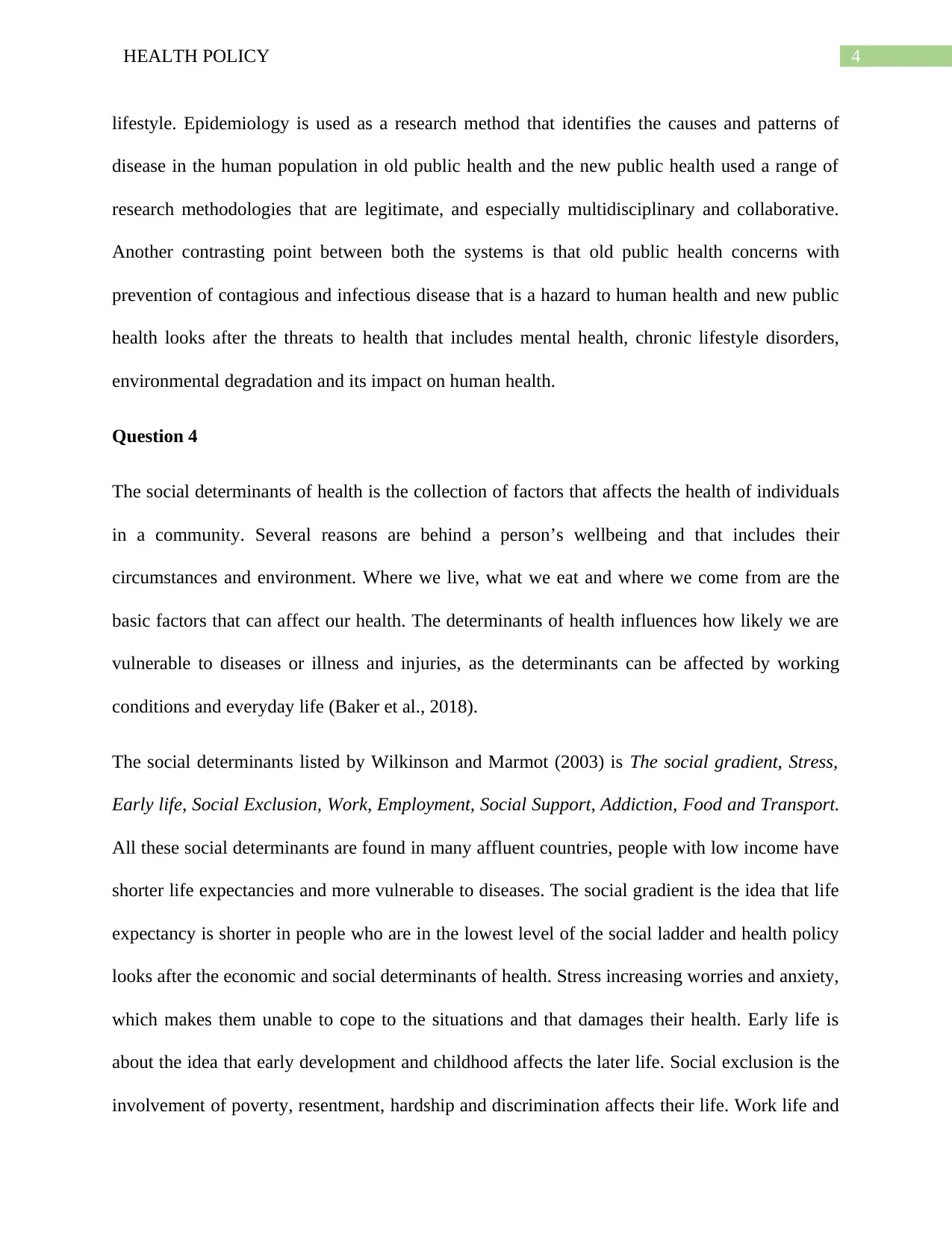
4HEALTH POLICY
lifestyle. Epidemiology is used as a research method that identifies the causes and patterns of
disease in the human population in old public health and the new public health used a range of
research methodologies that are legitimate, and especially multidisciplinary and collaborative.
Another contrasting point between both the systems is that old public health concerns with
prevention of contagious and infectious disease that is a hazard to human health and new public
health looks after the threats to health that includes mental health, chronic lifestyle disorders,
environmental degradation and its impact on human health.
Question 4
The social determinants of health is the collection of factors that affects the health of individuals
in a community. Several reasons are behind a person’s wellbeing and that includes their
circumstances and environment. Where we live, what we eat and where we come from are the
basic factors that can affect our health. The determinants of health influences how likely we are
vulnerable to diseases or illness and injuries, as the determinants can be affected by working
conditions and everyday life (Baker et al., 2018).
The social determinants listed by Wilkinson and Marmot (2003) is The social gradient, Stress,
Early life, Social Exclusion, Work, Employment, Social Support, Addiction, Food and Transport.
All these social determinants are found in many affluent countries, people with low income have
shorter life expectancies and more vulnerable to diseases. The social gradient is the idea that life
expectancy is shorter in people who are in the lowest level of the social ladder and health policy
looks after the economic and social determinants of health. Stress increasing worries and anxiety,
which makes them unable to cope to the situations and that damages their health. Early life is
about the idea that early development and childhood affects the later life. Social exclusion is the
involvement of poverty, resentment, hardship and discrimination affects their life. Work life and
lifestyle. Epidemiology is used as a research method that identifies the causes and patterns of
disease in the human population in old public health and the new public health used a range of
research methodologies that are legitimate, and especially multidisciplinary and collaborative.
Another contrasting point between both the systems is that old public health concerns with
prevention of contagious and infectious disease that is a hazard to human health and new public
health looks after the threats to health that includes mental health, chronic lifestyle disorders,
environmental degradation and its impact on human health.
Question 4
The social determinants of health is the collection of factors that affects the health of individuals
in a community. Several reasons are behind a person’s wellbeing and that includes their
circumstances and environment. Where we live, what we eat and where we come from are the
basic factors that can affect our health. The determinants of health influences how likely we are
vulnerable to diseases or illness and injuries, as the determinants can be affected by working
conditions and everyday life (Baker et al., 2018).
The social determinants listed by Wilkinson and Marmot (2003) is The social gradient, Stress,
Early life, Social Exclusion, Work, Employment, Social Support, Addiction, Food and Transport.
All these social determinants are found in many affluent countries, people with low income have
shorter life expectancies and more vulnerable to diseases. The social gradient is the idea that life
expectancy is shorter in people who are in the lowest level of the social ladder and health policy
looks after the economic and social determinants of health. Stress increasing worries and anxiety,
which makes them unable to cope to the situations and that damages their health. Early life is
about the idea that early development and childhood affects the later life. Social exclusion is the
involvement of poverty, resentment, hardship and discrimination affects their life. Work life and
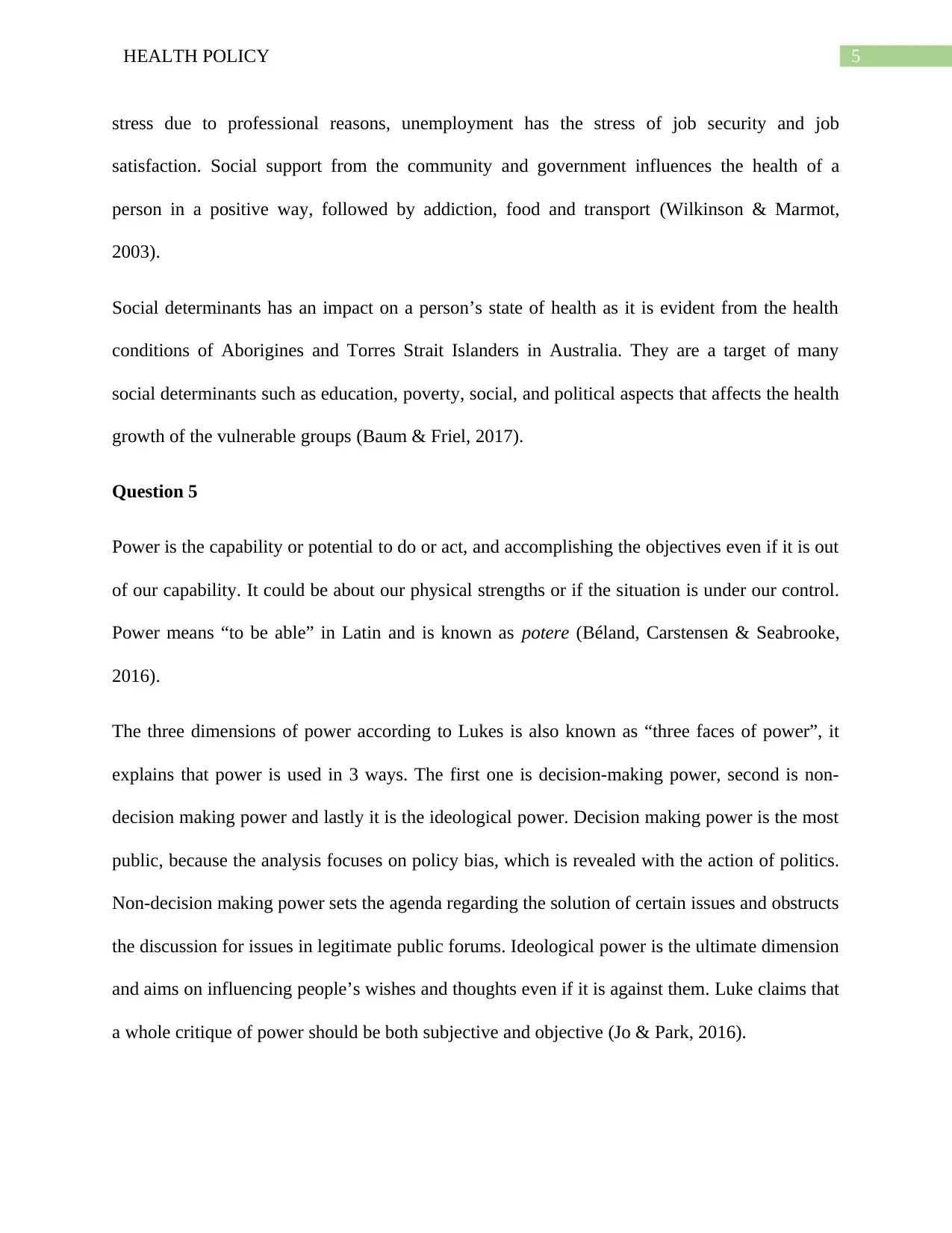
5HEALTH POLICY
stress due to professional reasons, unemployment has the stress of job security and job
satisfaction. Social support from the community and government influences the health of a
person in a positive way, followed by addiction, food and transport (Wilkinson & Marmot,
2003).
Social determinants has an impact on a person’s state of health as it is evident from the health
conditions of Aborigines and Torres Strait Islanders in Australia. They are a target of many
social determinants such as education, poverty, social, and political aspects that affects the health
growth of the vulnerable groups (Baum & Friel, 2017).
Question 5
Power is the capability or potential to do or act, and accomplishing the objectives even if it is out
of our capability. It could be about our physical strengths or if the situation is under our control.
Power means “to be able” in Latin and is known as potere (Béland, Carstensen & Seabrooke,
2016).
The three dimensions of power according to Lukes is also known as “three faces of power”, it
explains that power is used in 3 ways. The first one is decision-making power, second is non-
decision making power and lastly it is the ideological power. Decision making power is the most
public, because the analysis focuses on policy bias, which is revealed with the action of politics.
Non-decision making power sets the agenda regarding the solution of certain issues and obstructs
the discussion for issues in legitimate public forums. Ideological power is the ultimate dimension
and aims on influencing people’s wishes and thoughts even if it is against them. Luke claims that
a whole critique of power should be both subjective and objective (Jo & Park, 2016).
stress due to professional reasons, unemployment has the stress of job security and job
satisfaction. Social support from the community and government influences the health of a
person in a positive way, followed by addiction, food and transport (Wilkinson & Marmot,
2003).
Social determinants has an impact on a person’s state of health as it is evident from the health
conditions of Aborigines and Torres Strait Islanders in Australia. They are a target of many
social determinants such as education, poverty, social, and political aspects that affects the health
growth of the vulnerable groups (Baum & Friel, 2017).
Question 5
Power is the capability or potential to do or act, and accomplishing the objectives even if it is out
of our capability. It could be about our physical strengths or if the situation is under our control.
Power means “to be able” in Latin and is known as potere (Béland, Carstensen & Seabrooke,
2016).
The three dimensions of power according to Lukes is also known as “three faces of power”, it
explains that power is used in 3 ways. The first one is decision-making power, second is non-
decision making power and lastly it is the ideological power. Decision making power is the most
public, because the analysis focuses on policy bias, which is revealed with the action of politics.
Non-decision making power sets the agenda regarding the solution of certain issues and obstructs
the discussion for issues in legitimate public forums. Ideological power is the ultimate dimension
and aims on influencing people’s wishes and thoughts even if it is against them. Luke claims that
a whole critique of power should be both subjective and objective (Jo & Park, 2016).
⊘ This is a preview!⊘
Do you want full access?
Subscribe today to unlock all pages.

Trusted by 1+ million students worldwide
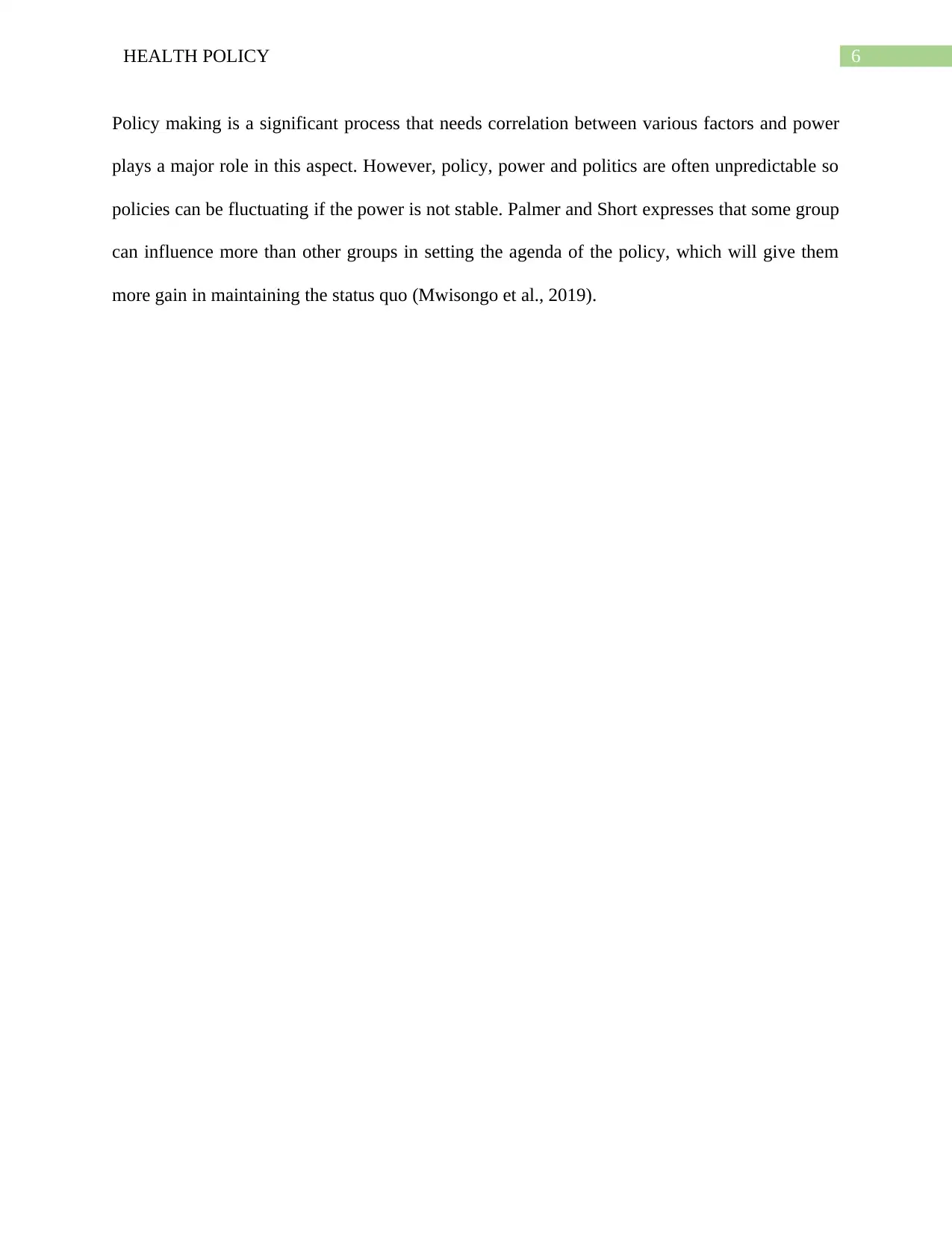
6HEALTH POLICY
Policy making is a significant process that needs correlation between various factors and power
plays a major role in this aspect. However, policy, power and politics are often unpredictable so
policies can be fluctuating if the power is not stable. Palmer and Short expresses that some group
can influence more than other groups in setting the agenda of the policy, which will give them
more gain in maintaining the status quo (Mwisongo et al., 2019).
Policy making is a significant process that needs correlation between various factors and power
plays a major role in this aspect. However, policy, power and politics are often unpredictable so
policies can be fluctuating if the power is not stable. Palmer and Short expresses that some group
can influence more than other groups in setting the agenda of the policy, which will give them
more gain in maintaining the status quo (Mwisongo et al., 2019).
Paraphrase This Document
Need a fresh take? Get an instant paraphrase of this document with our AI Paraphraser
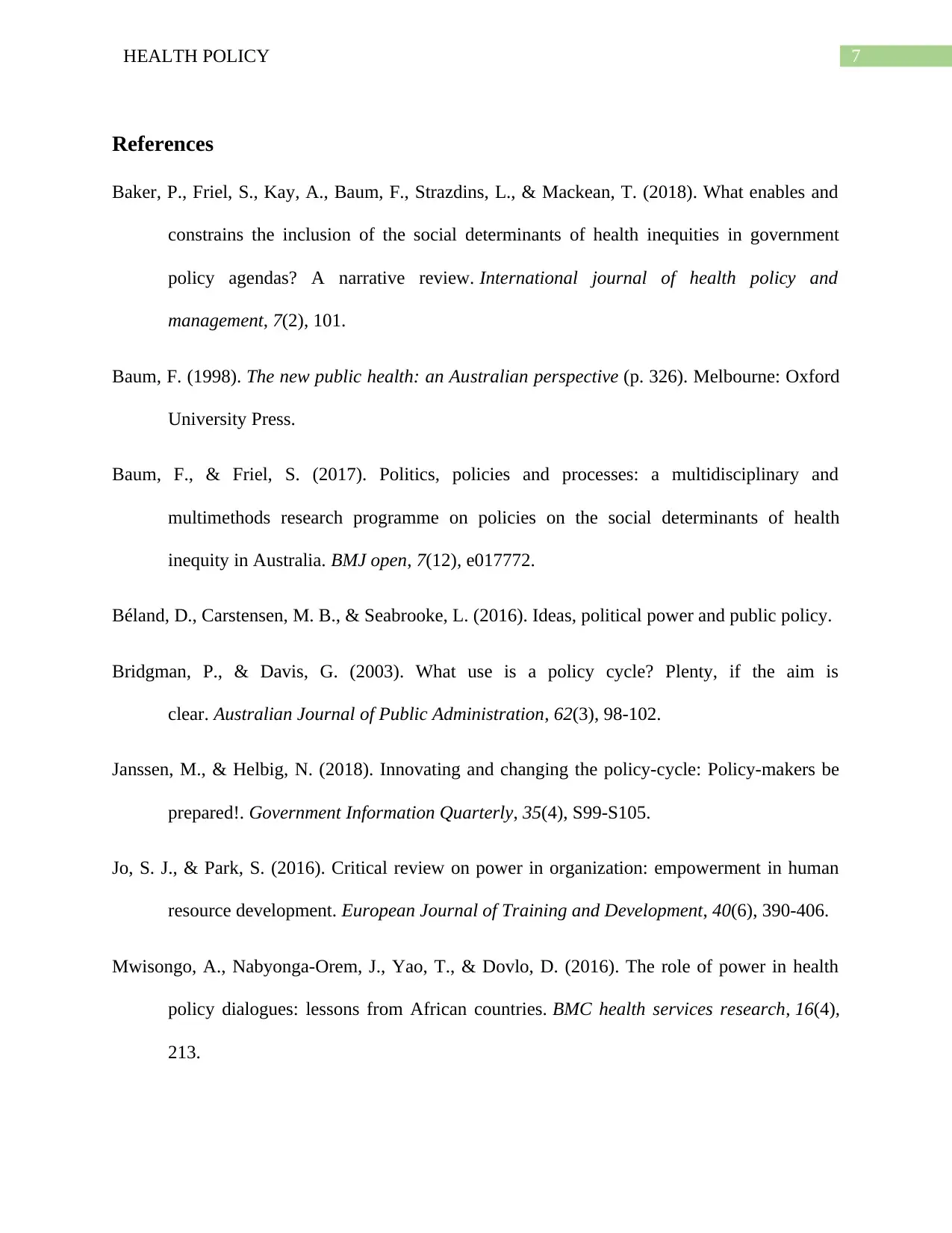
7HEALTH POLICY
References
Baker, P., Friel, S., Kay, A., Baum, F., Strazdins, L., & Mackean, T. (2018). What enables and
constrains the inclusion of the social determinants of health inequities in government
policy agendas? A narrative review. International journal of health policy and
management, 7(2), 101.
Baum, F. (1998). The new public health: an Australian perspective (p. 326). Melbourne: Oxford
University Press.
Baum, F., & Friel, S. (2017). Politics, policies and processes: a multidisciplinary and
multimethods research programme on policies on the social determinants of health
inequity in Australia. BMJ open, 7(12), e017772.
Béland, D., Carstensen, M. B., & Seabrooke, L. (2016). Ideas, political power and public policy.
Bridgman, P., & Davis, G. (2003). What use is a policy cycle? Plenty, if the aim is
clear. Australian Journal of Public Administration, 62(3), 98-102.
Janssen, M., & Helbig, N. (2018). Innovating and changing the policy-cycle: Policy-makers be
prepared!. Government Information Quarterly, 35(4), S99-S105.
Jo, S. J., & Park, S. (2016). Critical review on power in organization: empowerment in human
resource development. European Journal of Training and Development, 40(6), 390-406.
Mwisongo, A., Nabyonga-Orem, J., Yao, T., & Dovlo, D. (2016). The role of power in health
policy dialogues: lessons from African countries. BMC health services research, 16(4),
213.
References
Baker, P., Friel, S., Kay, A., Baum, F., Strazdins, L., & Mackean, T. (2018). What enables and
constrains the inclusion of the social determinants of health inequities in government
policy agendas? A narrative review. International journal of health policy and
management, 7(2), 101.
Baum, F. (1998). The new public health: an Australian perspective (p. 326). Melbourne: Oxford
University Press.
Baum, F., & Friel, S. (2017). Politics, policies and processes: a multidisciplinary and
multimethods research programme on policies on the social determinants of health
inequity in Australia. BMJ open, 7(12), e017772.
Béland, D., Carstensen, M. B., & Seabrooke, L. (2016). Ideas, political power and public policy.
Bridgman, P., & Davis, G. (2003). What use is a policy cycle? Plenty, if the aim is
clear. Australian Journal of Public Administration, 62(3), 98-102.
Janssen, M., & Helbig, N. (2018). Innovating and changing the policy-cycle: Policy-makers be
prepared!. Government Information Quarterly, 35(4), S99-S105.
Jo, S. J., & Park, S. (2016). Critical review on power in organization: empowerment in human
resource development. European Journal of Training and Development, 40(6), 390-406.
Mwisongo, A., Nabyonga-Orem, J., Yao, T., & Dovlo, D. (2016). The role of power in health
policy dialogues: lessons from African countries. BMC health services research, 16(4),
213.
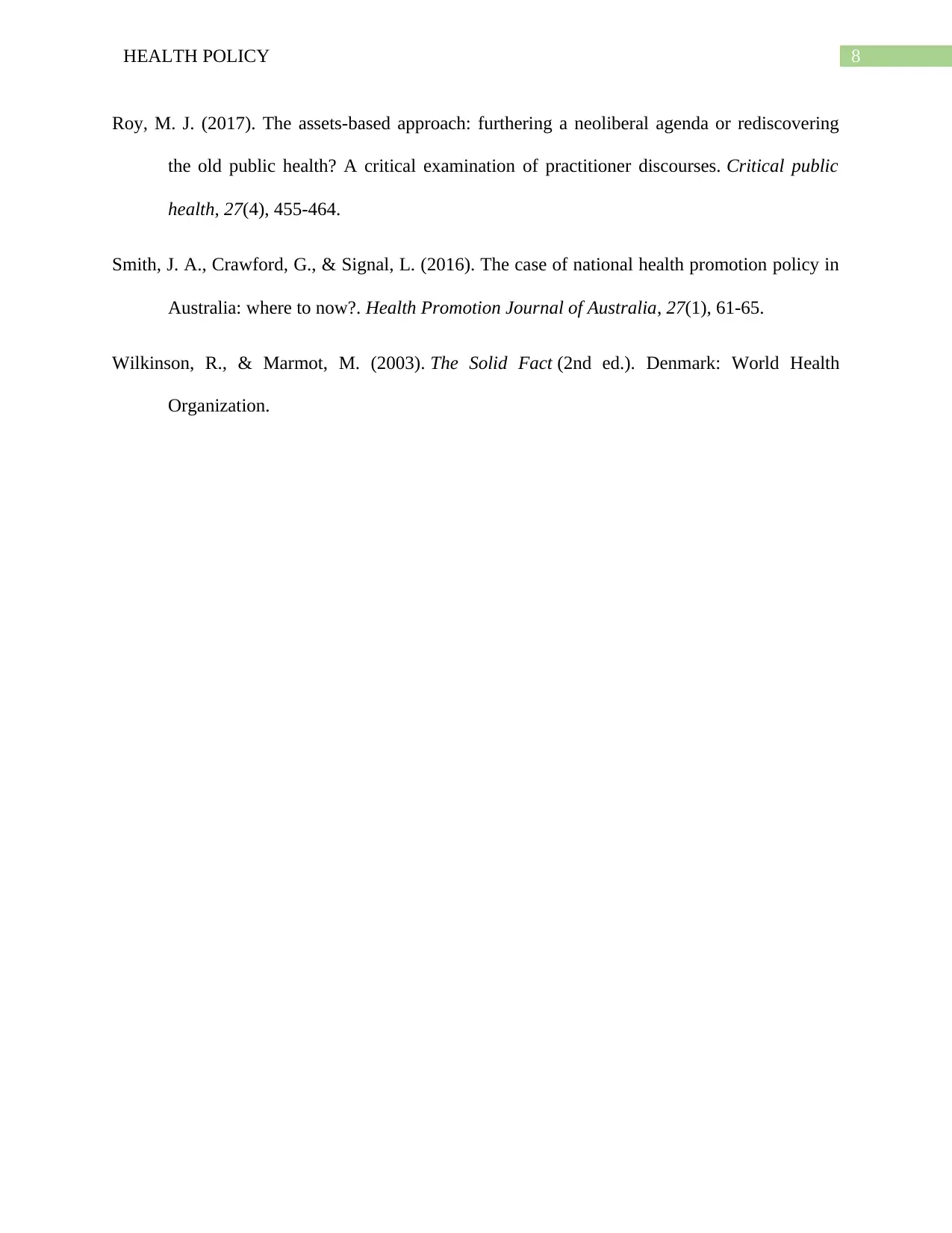
8HEALTH POLICY
Roy, M. J. (2017). The assets-based approach: furthering a neoliberal agenda or rediscovering
the old public health? A critical examination of practitioner discourses. Critical public
health, 27(4), 455-464.
Smith, J. A., Crawford, G., & Signal, L. (2016). The case of national health promotion policy in
Australia: where to now?. Health Promotion Journal of Australia, 27(1), 61-65.
Wilkinson, R., & Marmot, M. (2003). The Solid Fact (2nd ed.). Denmark: World Health
Organization.
Roy, M. J. (2017). The assets-based approach: furthering a neoliberal agenda or rediscovering
the old public health? A critical examination of practitioner discourses. Critical public
health, 27(4), 455-464.
Smith, J. A., Crawford, G., & Signal, L. (2016). The case of national health promotion policy in
Australia: where to now?. Health Promotion Journal of Australia, 27(1), 61-65.
Wilkinson, R., & Marmot, M. (2003). The Solid Fact (2nd ed.). Denmark: World Health
Organization.
⊘ This is a preview!⊘
Do you want full access?
Subscribe today to unlock all pages.

Trusted by 1+ million students worldwide
1 out of 9
Related Documents
Your All-in-One AI-Powered Toolkit for Academic Success.
+13062052269
info@desklib.com
Available 24*7 on WhatsApp / Email
![[object Object]](/_next/static/media/star-bottom.7253800d.svg)
Unlock your academic potential
Copyright © 2020–2025 A2Z Services. All Rights Reserved. Developed and managed by ZUCOL.




